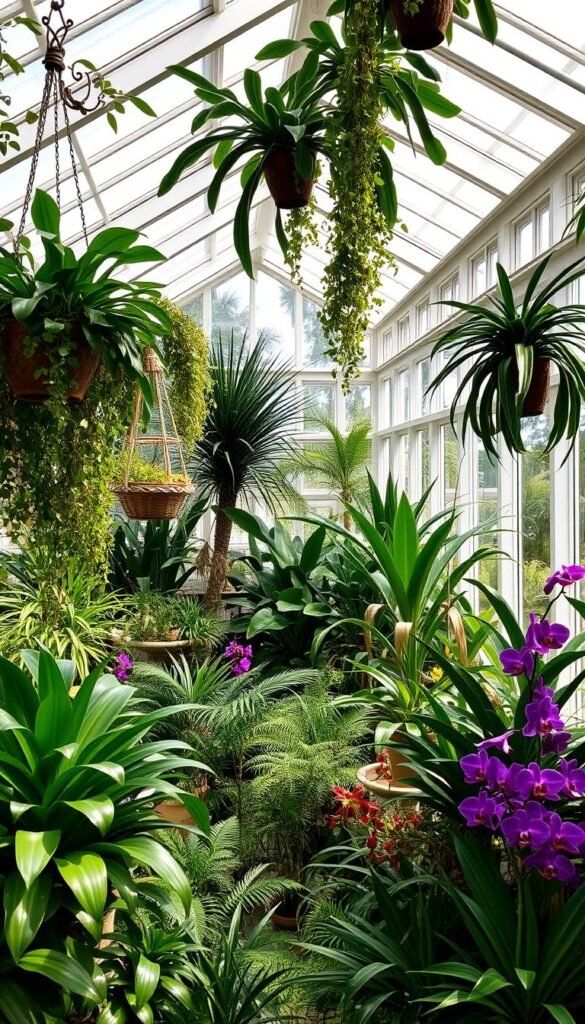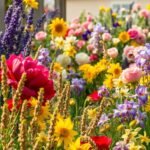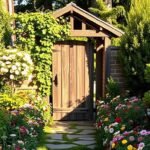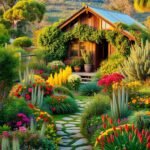Imagine stepping into a vibrant sanctuary where leafy wonders transform everyday rooms into living art galleries. Uncommon greenery with striking shapes and colors offers more than decoration – it creates dynamic ecosystems that refresh your surroundings and spark joy.
These extraordinary specimens turn blank walls into tropical escapes and empty corners into conversation hotspots. From velvety-textured leaves to flamboyant blooms, each piece adds personality while connecting you to Earth’s diverse landscapes. Discover how to blend functionality with wild elegance through thoughtful plant selection.
Our guide simplifies designing spaces that mirror professional conservatories without sacrificing comfort. You’ll learn to balance visual drama with practical care, whether creating sunny window displays or shaded nooks. For those drawn to whimsical outdoor spaces, explore how cottagecore-inspired garden designs complement indoor arrangements through harmonious plant pairings.
Ready to craft your personal Eden? We’ll reveal secrets for maintaining thriving collections that reflect your unique style. Transform ordinary areas into extraordinary showcases where nature’s beauty takes center stage – no green thumb required!
Immersing Yourself in a Botanical Journey at Home
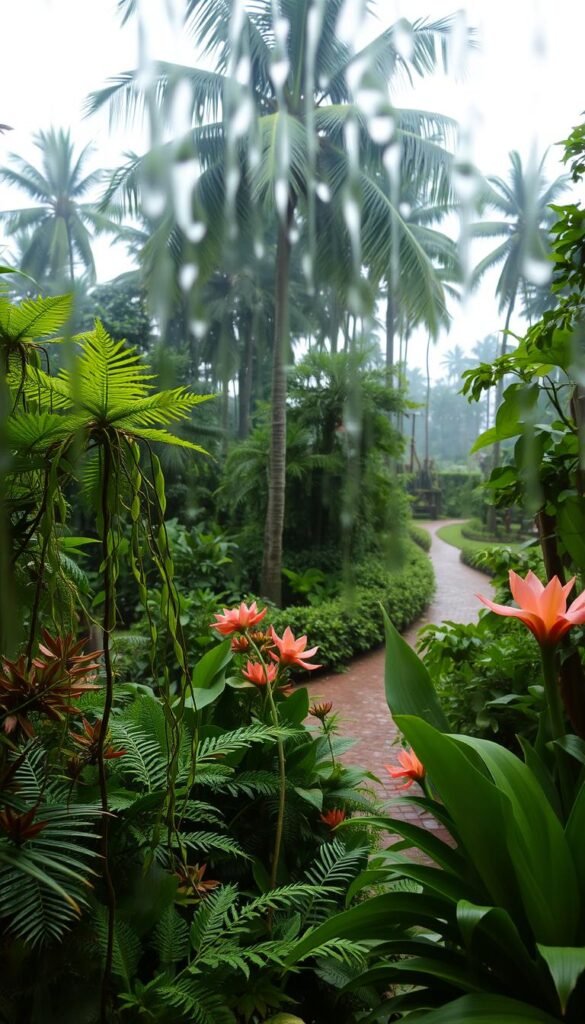
Embark on a green adventure that turns your home into a thriving oasis of rare flora. This experience lets you explore Earth’s biodiversity through carefully chosen greenery that thrives indoors. You’ll discover how even small spaces can mirror the energy of wild ecosystems.
Discovering the Magic of Exotic Plant Life
Unusual species bring drama to rooms with leaves that shimmer, twist, or boast rainbow hues. Start with hardy varieties like Monstera deliciosa or Calathea orbifolia—their striking patterns make instant statements. Pair these with flowering gems like Anthurium for pops of color.
| Plant Type | Light Needs | Humidity Level | Growth Speed |
|---|---|---|---|
| Bird of Paradise | Bright indirect | 60-70% | Moderate |
| String of Pearls | Medium light | 40-50% | Slow |
| Rubber Plant | Low to bright | 50-60% | Fast |
Setting the Mood for a Lush Indoor Oasis
Create depth by layering plants at different heights—hang trailing vines near sunlit windows and place tall palms in dim corners. Use pebble trays to boost moisture for tropical varieties. Rotate pots weekly so all sides get equal light exposure.
Watch how morning sun highlights leaf textures, transforming ordinary shelves into living displays. With time, you’ll recognize subtle changes that signal your green companions’ needs—a curled leaf here, a new shoot there. This connection turns care routines into mindful moments of growth.
Botanical Garden Aesthetic at Home: Curating Rare and Exotic Plant Species
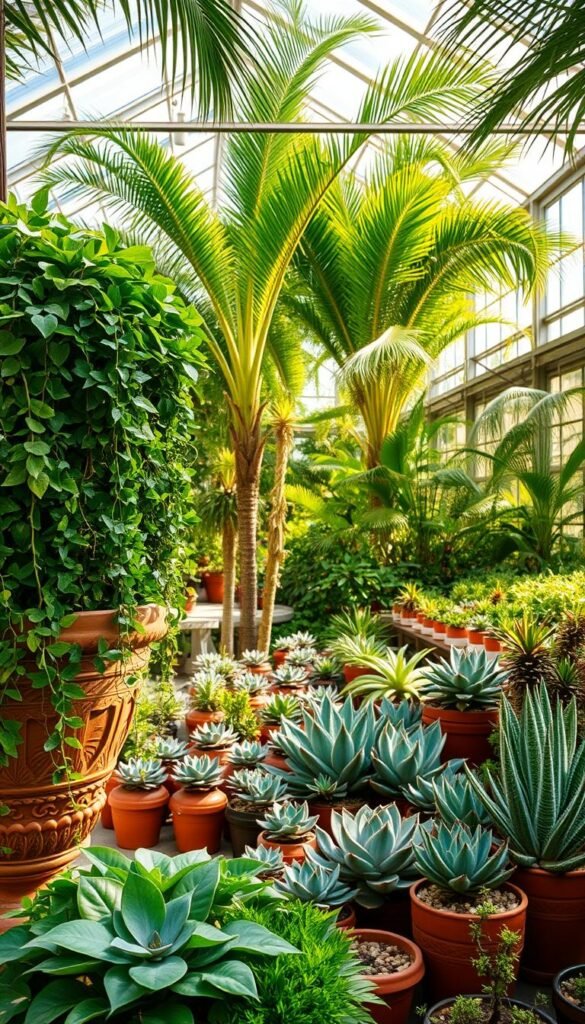
Transform your space into a gallery of nature’s masterpieces by applying design strategies from professional conservatories. Start by choosing specimens that create visual harmony through contrasting leaf shapes and complementary colors. A velvety Begonia maculata pairs beautifully with spiky Sansevieria, while trailing Pothos softens angular shelves.
Group your flora based on their native environments to simplify care. Tropical varieties like Heliconia thrive together in humid corners, while succulents form drought-tolerant clusters near sunny windows. This approach mimics natural ecosystems, encouraging healthier growth while creating cohesive displays.
Treat each plant as a sculptural element in your evolving collection. A towering Fiddle Leaf Fig becomes a focal point, while delicate vibrant container arrangements add pops of color. Observe how light interacts with foliage textures—place iridescent Calatheas where morning sun highlights their shimmering leaves.
Build your indoor garden gradually, prioritizing quality over quantity. Seek out unusual species like carnivorous Nepenthes or trailing Hoya linearis that spark curiosity. Track growth patterns to anticipate spacing needs, ensuring each new addition enhances your existing botanical narrative without overcrowding.
Selecting and Sourcing Rare and Exotic Plant Species
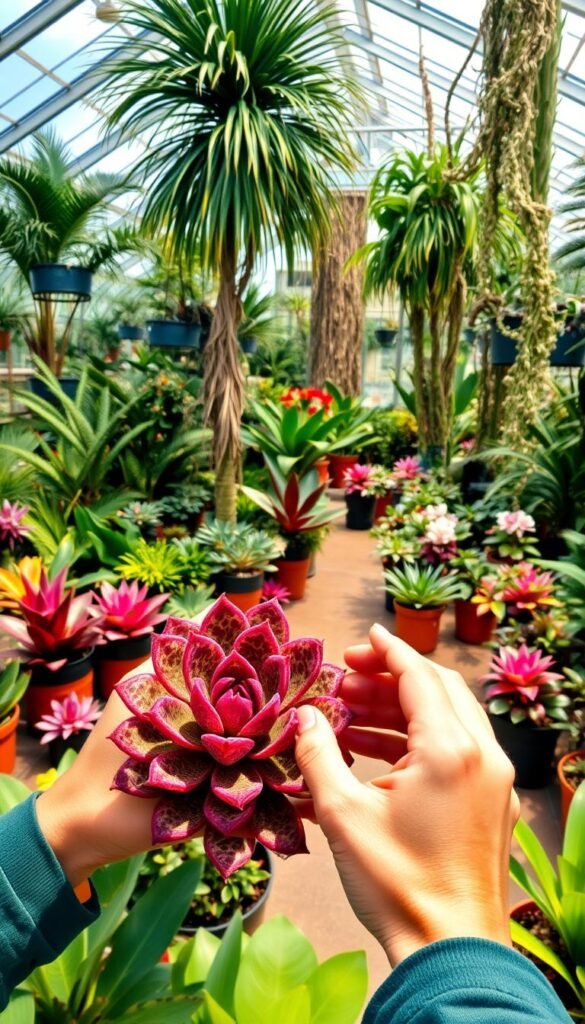
Building your dream collection starts with knowing where to find nature’s hidden treasures. Specialty growers and trusted vendors offer access to jaw-dropping plant species like Borneo’s fanged pitcher plants or Central America’s Dracula orchids. These living wonders bring global biodiversity to your space while challenging traditional gardening norms.
Exploring Local Nurseries and Online Sources
Start by visiting growers who specialize in unusual specimens. Many host seasonal sales featuring century-old cycads or Kenyan hibiscus hybrids. For hard-to-find varieties, online shops like Glasshouse Works deliver healthy starters with detailed care guides. Always check seller reviews and phytosanitary certifications.
For those expanding beyond indoor displays, discover patio container gardening tips that complement exotic collections. Local plant swaps often yield rare finds—experienced collectors frequently trade cuttings from their prized species.
Researching Unique Plant Specimens and Cultivars
Dig deeper than photos when selecting new additions. Study growth habits—does that variegated monstera need 80% humidity? Verify scientific names to avoid mislabeled plants. Reputable sources provide origin details, helping you recreate native conditions.
Connect with botanical institutions to learn about newly available specimens. Many now sell propagated rarities once found only in remote world regions. With careful sourcing, your home becomes a living showcase of Earth’s most extraordinary flora.
Creating the Ideal Environment for Your Exotic Collection
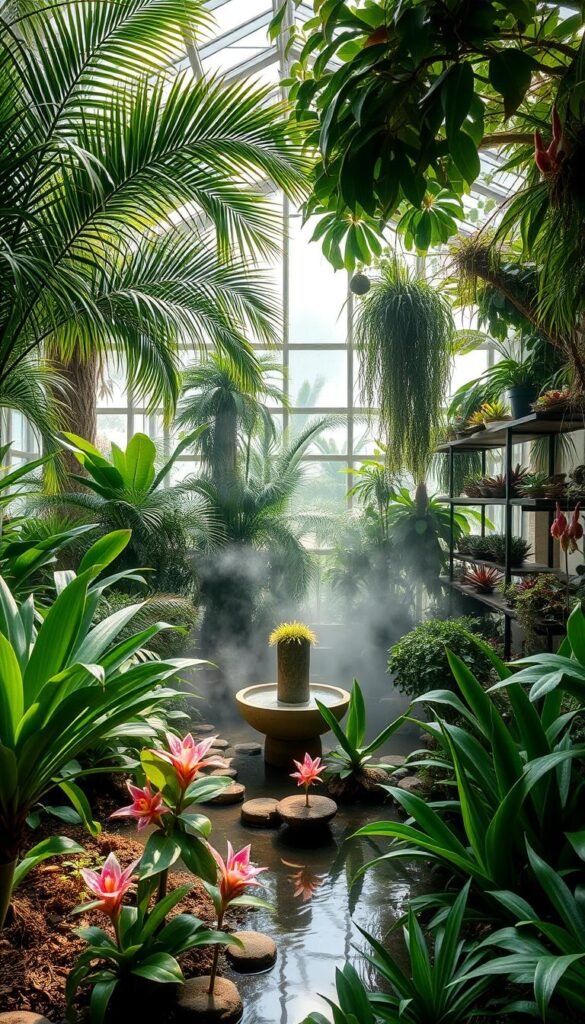
Crafting the perfect habitat for your leafy treasures starts with understanding their natural rhythms. Your space becomes a stage where light, moisture, and warmth work together to showcase nature’s artistry.
Lighting, Watering, and Humidity Essentials
Bright, indirect light keeps most tropical varieties thriving—position them near east-facing windows or behind sheer curtains. For sun-shy plants, try north-facing spots or LED grow lights set 12 inches above foliage.
Check soil moisture by pressing your finger an inch deep. Water when dry, using room-temperature liquid to avoid root shock. Group moisture-loving species on pebble trays filled with water to boost humidity naturally.
Temperature Control and Seasonal Adjustments
Maintain daytime temps between 68-82°F for optimal growth. Nighttime drops to 65°F mimic jungle conditions many plants adore. Use digital thermometers to monitor your environment.
Rotate pots monthly for even growth as seasons change. Reduce care frequency in winter when growth slows. Remember—highland varieties like cool mist, while lowland types crave steamy air. Your attentiveness turns challenges into thriving displays.
Designing Creative Displays for Indoor and Outdoor Spaces
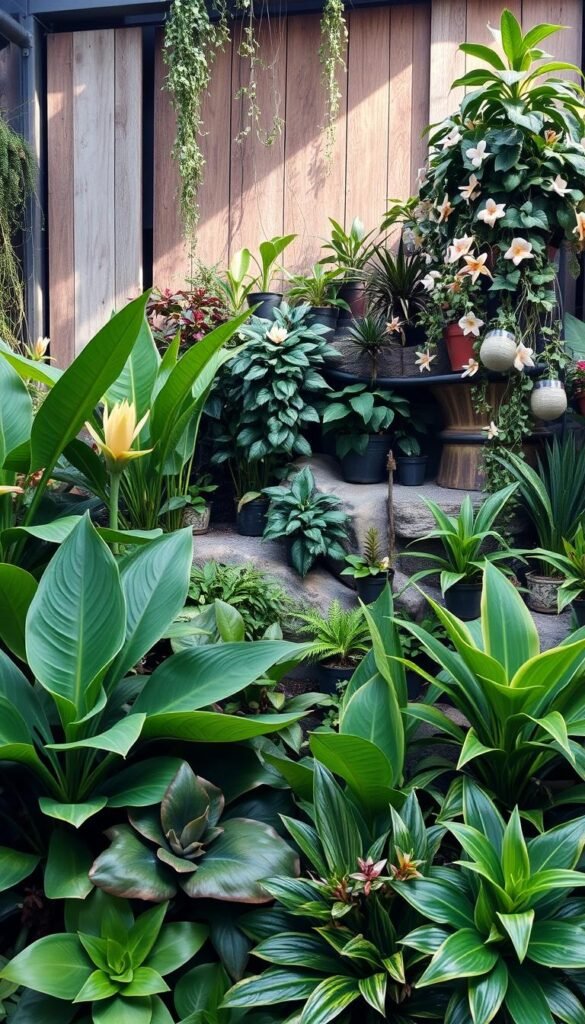
Turn every corner into a living masterpiece by arranging your greenery like gallery installations. Victorian-inspired collections prove that strategic placement transforms ordinary displays into conversation starters. Start with three statement pieces – a towering focal plant, mid-sized textural interest, and trailing accents.
Mixing Colors, Textures, and Heights
Combine spiky Dracaena with velvety Philodendron for tactile contrast. Place golden pothos beneath burgundy rubber trees to make vibrant colors pop. Use stands and shelves to create elevation changes that guide the eye upward.
| Container Type | Best For | Style Impact |
|---|---|---|
| Copper Urns | Tropicals | Warm & Luxe |
| Javanese Palm Pots | Ferns | Organic Texture |
| Ceramic Planters | Succulents | Modern Minimal |
Rotate seasonal bloomers like bromeliads into your arrangements for surprise bursts of color. In outdoor areas, pair water lilies with giant taro leaves in weathered stone basins. Remember: odd-number groupings often feel more dynamic than symmetrical layouts.
For cohesive themes, repeat one container material across different display zones. Hang macramé planters near matching floor pots to connect spaces visually. This approach lets you create stunning transitions between rooms while honoring each plant’s needs.
Maintaining the Health and Beauty of Your Exotic Plants
Your thriving collection deserves attentive care to maintain its splendor. A consistent routine preserves vibrant foliage and prevents common issues before they escalate. Let’s explore methods that keep your greenery robust while enhancing its natural charm.
Pest Management and Organic Fertilization
Spot pests early by checking leaf undersides weekly. Neem oil sprays disrupt aphid life cycles without harsh chemicals. For mealybugs, dab affected areas with cotton swabs dipped in rubbing alcohol.
| Fertilizer Type | Key Nutrients | Application Frequency | Best For |
|---|---|---|---|
| Compost Tea | Nitrogen, Microbes | Monthly | Tropicals |
| Worm Castings | Phosphorus, Potassium | Every 6 Weeks | Flowering Species |
| Seaweed Extract | Trace Minerals | Biweekly | Slow-Growers |
Feed specimens from spring through summer when growth peaks. Dilute fertilizers to half-strength to avoid root burn. Rotate nutrient sources for balanced soil health.
Routine Pruning and Regular Maintenance Tips
Trim yellowing leaves at the stem base using sterilized shears. Shape overgrown vines by cutting above leaf nodes—this encourages bushier growth. Wipe dust from broad leaves monthly to maximize photosynthesis.
Create a weekly checklist: check soil moisture, rotate pots, and inspect for stress signals. Record observations in a care journal to track patterns. Your plants will reward this diligence with lush, photogenic displays.
Drawing Inspiration from Local Botanical Gardens
Local green spaces become your personal design lab when crafting nature-inspired displays. The Conservatory of Flowers in San Francisco demonstrates this beautifully with themed zones like misty Highland Tropics and steamy Lowland jungle environments. These professional ecosystems reveal clever solutions for grouping species and managing microclimates.
Bring a notebook during visits to document successful pairings—like floating water lilies beside upright taro stems in aquatic displays. Notice how curators use elevation changes and decorative stones to highlight key features. Snap photos of container arrangements that balance color and texture, then adapt these concepts using accessible materials.
Many institutions host workshops teaching propagation techniques perfect for home use. Their annual plant sales often feature unusual cultivars rarely found elsewhere. Consider memberships for exclusive access to expert talks and behind-the-scenes tours.
| Garden Feature | Home Adaptation | Key Benefit |
|---|---|---|
| Cloud Forest Misting | Pebble trays & humidifiers | Humidity control |
| Epiphyte Displays | Mounted staghorn ferns | Space efficiency |
| Themed Color Blocks | Grouped coleus varieties | Visual impact |
Observe how professionals rotate seasonal blooms to maintain year-round interest. Apply this strategy by introducing flowering orchids in spring and fiery crotons during fall. Your appreciation for nature’s diversity will deepen as you reinterpret these grand designs in cozy corners.
Incorporating Sustainable Practices for Long-Term Care
Caring for your greenery becomes a gift to the planet when you adopt Earth-friendly methods. Simple changes in routine help your plants thrive while protecting local ecosystems. Let’s explore how to harmonize lush growth with environmental stewardship.
Eco-Friendly Watering and Soil Management
Save water without compromising care. Collect rainwater in barrels for thirsty tropicals, or repurpose pasta cooking liquid after it cools. Drip irrigation systems cut usage by 50% compared to sprinklers.
| Practice | Purpose | Benefit |
|---|---|---|
| Mulching | Retain soil moisture | Reduces watering frequency |
| Vermicomposting | Enrich soil naturally | Lowers fertilizer needs |
| Self-watering pots | Prevent runoff | Minimizes waste |
Boost soil health with kitchen scraps. Blend coffee grounds into potting mix for acidity-loving plants. Crushed eggshells add calcium while deterring slugs. Always choose peat-free mixes to protect bog ecosystems.
Support the natural world by sourcing from nurseries using ethical propagation. Many rare species now get cloned through leaf cuttings instead of wild harvesting. Your choices help preserve global biodiversity.
Close the loop by repurposing containers. Turn old colanders into hanging planters with added moss liners. These small acts create thriving micro-environments that mirror nature’s genius.
Embracing Your Botanical Journey with Confidence
Your green sanctuary evolves with every leaf unfurled and bloom revealed. This adventure grows your skills alongside your living collection, turning uncertainties into proud milestones. Each new addition becomes a chapter in your ever-expanding story of growth.
Feast your eyes on nature’s artistry as trailing vines cascade and broad leaves stretch toward sunlight. These wonders reward patience, teaching resilience through their seasonal rhythms. Your space transforms organically, reflecting lessons learned through trial and triumph.
Let curiosity guide you as you embark on this botanical path. Mistakes become stepping stones, not setbacks—every wilted leaf offers insight. With time, you’ll instinctively balance care routines with creative flair.
Your thriving collection stands as proof of deepened appreciation for Earth’s diversity. Continue embracing the journey, knowing each day brings fresh opportunities to nurture beauty. The adventure never truly ends—it simply grows richer.

